All about profiles for LED strips

The benefits of LED lighting are well known and beyond question. Thanks to the unique spectral composition, which is as close as possible to natural light, you can create a cozy atmosphere in almost any conditions. With the help of a whole arsenal of special devices, the list of which includes profiles for LED strips, such lighting systems fit into any interior. The design features of such boxes allow taking into account all the nuances of the object or product being designed.

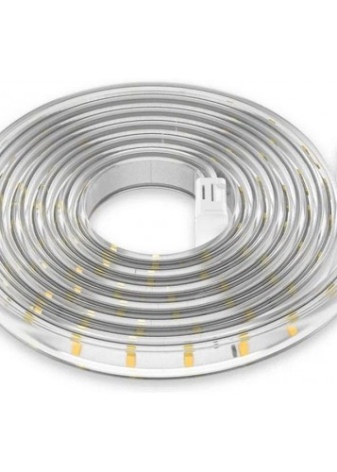
What is it and why is it needed?
Very often, for the installation of both the main lighting systems and interior lighting elements, LED strips are used, which make it possible to form a narrow, directional stream of light. A special, correctly selected profile will ensure reliable fixation of such tapes, as well as their protection from almost all influences, which in itself maximizes the service life of the devices. Today in the corresponding market segment there is more than a wide range of the described mounting elements for diode illumination.
The scope of the profile is determined by the similar characteristics of the LED strips themselves. They are used in the design of a wide variety of rooms and objects. In this case, we are talking about both the interior and the illumination of the facades of buildings, flights of stairs and even footpaths. One of the most popular applications for such structures is the design of shop windows and entire zones in shopping pavilions. Also, a profile of one type or another can be found in beauty salons.
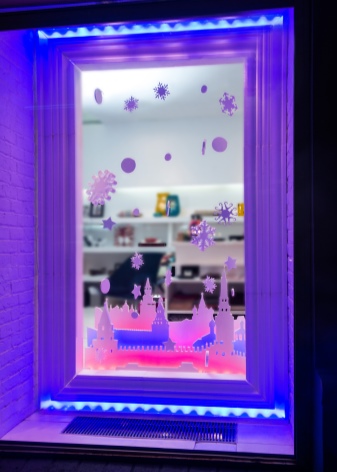
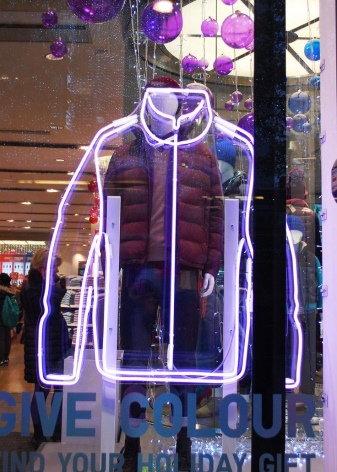
Deserves special attention versatility... The fact is that the described devices are characterized by increased resistance to the negative effects of moisture. Based on this, LED mounting strips can be installed almost anywhere, including car washes and even swimming pools. An equally important point is that the street profile, regardless of its shape, is sealed, that is, it provides full protection of the light line. Taking into account the operational characteristics of the boxes, they are installed under the tiles to illuminate the floor or on the walls under the putty.
Structurally, the profile is an aluminum, plastic, silicone guide made of polycarbonate or other material with a removable screen. The latter has scattering properties and can be either matte or completely transparent.
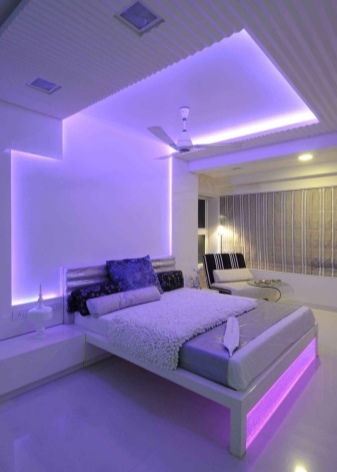

It is important to consider that regardless of the configuration and installation features, these products not only play the role of a decorative element, they also perform the following functions.
- Effective heat dissipation. In this context, special attention should be paid specifically to aluminum models, since due to its characteristics, the material guarantees appropriate heat transfer. This, in turn, almost completely eliminates the risk of overheating of the diode strip, and therefore, maximizes its service life and reduces operating costs.
- Creating the most comfortable indoor conditions due to the scattering effect of sufficiently bright light, which has a point structure.
- Effective protection of LED strips from moisture penetration, exposure to an aggressive environment (for example, in the kitchen - from fat, steam and burning) and damage.
- Possibility of implementation any design ideas.
- Simple assembly lighting systems, including in hard-to-reach places, taking into account the design features of the object being designed.
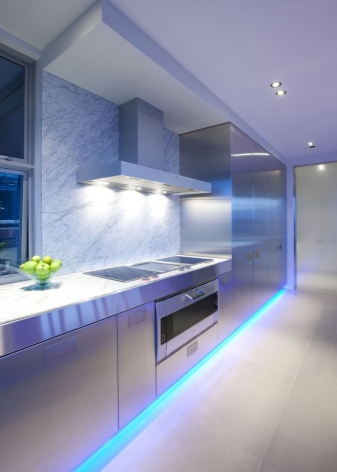
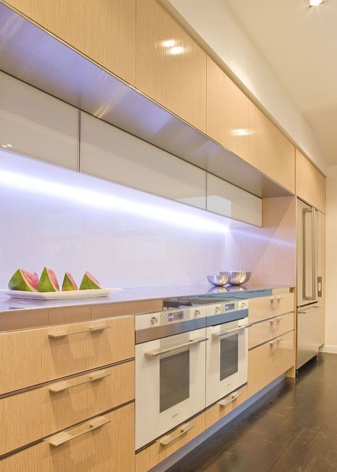
When installing a lighting system outside buildings and on street objects, it is necessary to take into account a whole list of factors. First of all, we are talking about the peculiarities of climatic conditions, as well as the likelihood of mechanical damage to the structure.
Species overview
The options available today for the devices in question are classified according to several main parameters. First of all, we are talking about the method and features of the installation of the guides, as well as their purpose. In addition, manufacturing companies offer the potential consumer planks of various shapes, designs and sizes. In parallel, a whole arsenal of additional elements is presented on the market, including, for example, X-shaped connectors.
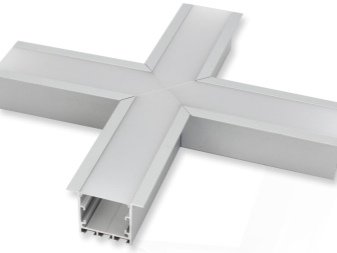
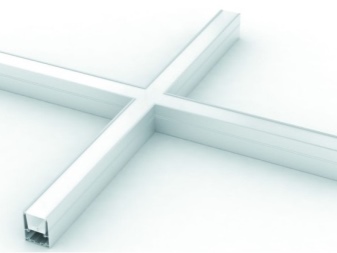
On sale you can find a fairly wide range of profiles for LED strips. In addition to the classic rectangular or square options, boxes with decorative elements are available, as well as radius models. Suspended options are a separate category, which are widely and effectively used in the installation of lighting and lighting systems in large rooms. The suspended structure eliminates the so-called blind spots and provides uniform illumination of the entire perimeter.
Corner
This type of profile, taking into account the configuration features, is an optimal alternative to flat guides, if the installation of the latter is impossible for one reason or another. Most often, such strips are mounted in the form of cornices or baseboards. This arrangement of LED lines around the perimeter provides uniform illumination of the room and any other room.
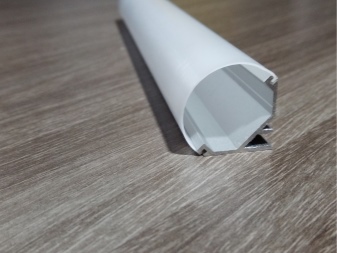
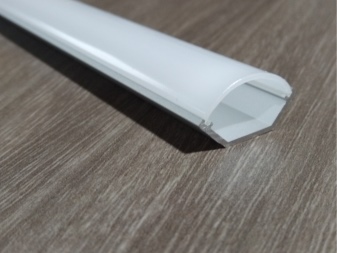
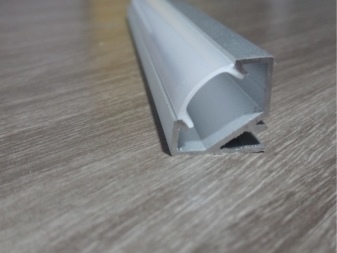
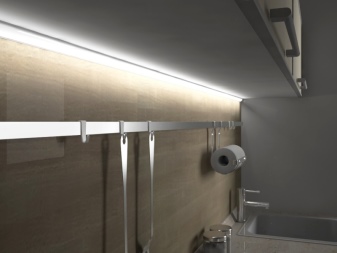
In addition, such a profile is relevant for the design of steps, door and window openings, as well as various cabinets and showcases. It can often be seen on outdoor advertising objects.
Embedded
Such strips for LEDs are successfully used in the implementation of most design concepts. These lighting system elements are often mounted between different materials and trim segments. This approach allows you to successfully decorate such joints, and, if necessary, emphasize them. As a rule, the profile diffuser is mounted flush with the surface.
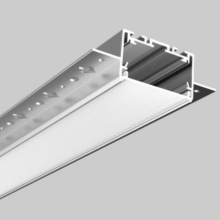
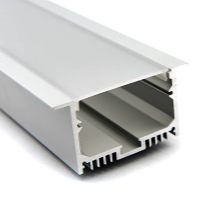
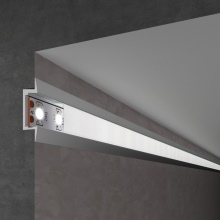
Overhead
This category of the described products can be described as a universal... Taking into account the design features of the boxes, various installation methods are available. Overhead profile models have a classic U-shape. At the same time, they can be equipped with screens that allow you to adjust the degree of scattering of bright point light, depending on the illumination of the room.
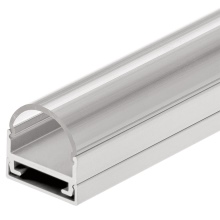
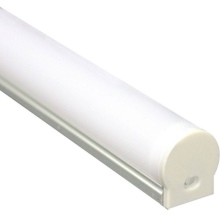
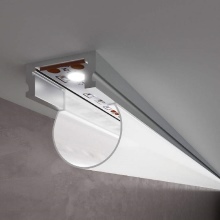
Mortise
Similar guides for LED strips are T-shaped, as well as a special configuration of one of the side surfaces, which allows you to hide irregularities at the installation site. Such devices are often used when decorating interior elements in kitchens, or rather, to illuminate work surfaces. It is important to take into account that the profile screen should not protrude if possible. As a result, the effect of glowing furniture and other elements from the inside is successfully created.
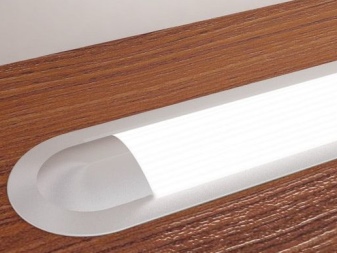


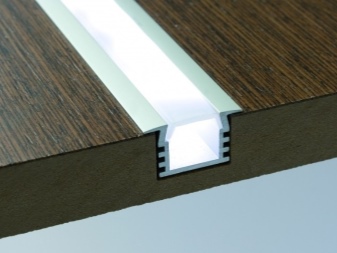
Flexible
The main characteristics and properties of these options for guides used for mounting LED backlighting can be determined based on the name of the profile. Manufacturers offer wide and thin flexible guides of various shapes. These products are characterized by a fairly high strength and aesthetics.... However, their key competitive advantage is their versatility. They can be installed almost anywhere, including hard-to-reach places in which the use of other options is not possible due to the design features of the room.
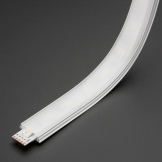
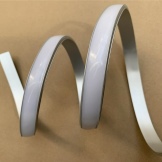
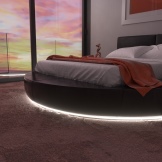

Diffuse screens
When analyzing the performance indicators of various modifications of profiles, including, of course, flexible ones, special attention should be paid to the diffusers. This structural element makes it possible to make the light of the diode strips more comfortable for human perception. Due to refraction, the flux angle increases, and the light is evenly distributed.
Diffuse screens make transparent and matte. Wherein the latter are more efficient. Some models are capable of reducing the flow rate up to 30%. When using transparent options, the loss of LED brightness is no more than 5%. Such boxes are used not so much to adjust the direction of the luminous flux and change its characteristics, but to protect the tape itself from moisture, dust and mechanical damage. It is important to take into account that from the point of view of protective functions, matte diffusers are in no way inferior to their transparent "brothers".
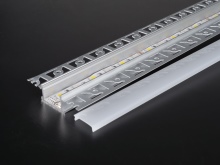
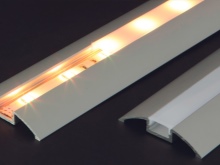
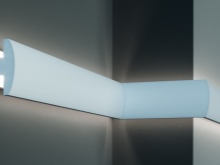
Materials (edit)
According to numerous reviews and according to current statistics, most often they use a profile made of aluminum or plastic. However, other models are also available, including products made of silicone and PVC. Naturally, each of the types of guides for LED strips has certain features, largely determined by the characteristics of the source material. Having an idea of them, you can make the right choice in favor of one or another option in each case.
Models made of plastic, usually, are cheaper. Moreover, all manufacturers have such a profile in a fairly wide range. As a result, it turns out to bring to life any idea when decorating the interior and outdoor objects. The plastic profile is available not only in different standard sizes, but there is also a choice in texture and color. In the catalogs you can find white, black and wood-like products.

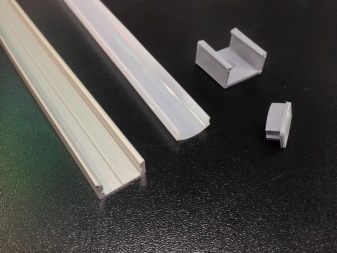


One of the clear and key advantages of the described type of boxes for mounting lighting and decorative lighting systems is the flexibility of the material. Elasticity in this case allows you to create different contours, taking into account the characteristics of the object. At the same time, plastic is equally successfully installed both indoors and outdoors.
The aluminum alloy profile is distinguished, first of all, by its strength and durability. In parallel, it is worth focusing on the effectiveness of protecting LED strips from external factors. It is important to remember that the aluminum boxes themselves are practically not subject to corrosion, which is the result of frequent ingress of moisture. Such performance characteristics make it possible to install such products even in difficult climatic conditions.
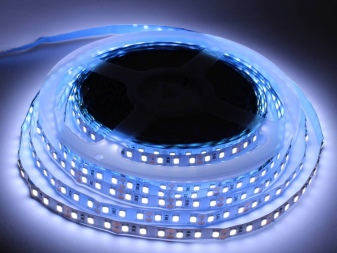
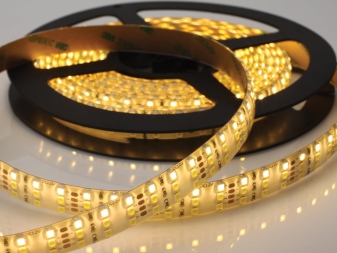
Many well-known manufacturers anodize the profile surface in order to give their products the most presentable appearance and improve their key properties. Also, the list of advantages of aluminum products includes versatility and ease of installation.
With the installation of such boxes, you can completely cope on your own with minimal skills and the necessary tools.
Shapes and sizes
The main geometric parameters of any profile for LEDs are width and depth. In addition, the length of the guides also matters. Of course, when choosing a particular standard size, it is strongly recommended to take into account the characteristics of the tape itself, as well as the design features of the base on which the boxes will be installed. For example, for 20 mm tapes, the optimal solution would be a profile with a cross section of 30x30. Besides, do not forget about the need to install a power supply unit and a controller, the dimensions of which are also a determining factor.
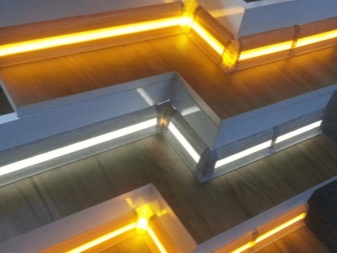
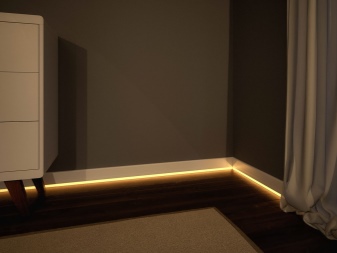
Width and depth standard products, regardless of the material of manufacture, varies in the range from 10 to 100 mm and from 5 to 50 mm respectively. It should be borne in mind that a wider box allows you to conveniently place all elements of the lighting system... In the process of selecting a specific type of profile, it is recommended to have a small piece of tape with you that you can put in the box and make sure that it fits. The length of each rail is determined taking into account the length and characteristics of the segments of the contour to be mounted, the length of which is most often from 1 to 5 m. As a rule, preference is given to slats 2-3 meters long.
The described products can take the following forms.
- Rectangle or square - the most common type of boxes.
- Round profile... The variety is universal and allows you to equip lighting systems in almost any room, regardless of the complexity of its design. We are talking, in particular, about the installation of complex track systems.
- Triangular patterns, which are relevant in cases where the installation of other options is impossible or too difficult. Given the increased strength, it is often the triangular profile that is mounted on the floor covering. Also an important point is the ability to install the tape at an angle.
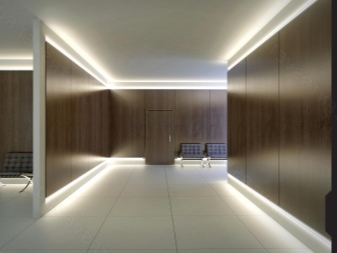

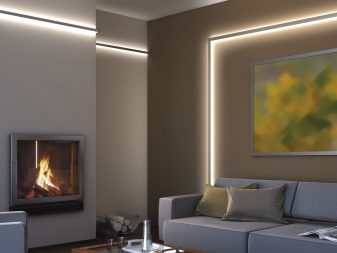
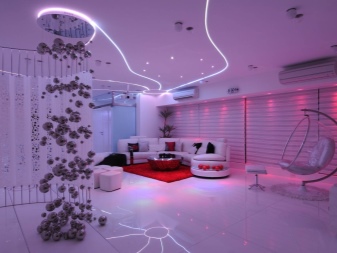
In addition to all the listed options, manufacturers also offer non-standard solutions. Meaning trapezoidal and conical boxes.
Popular models
Taking into account the increased demand both for LED lighting and decorative lighting systems themselves, and for installation elements, manufacturers present more than a wide range of products in the corresponding market segment. The list of the most popular brands includes representatives of the following model lines.
- Rectangular and corner profiles produced by Korean firms. The length of these guides is 2 meters. The products are simple in shape and are offered mainly in light shades.
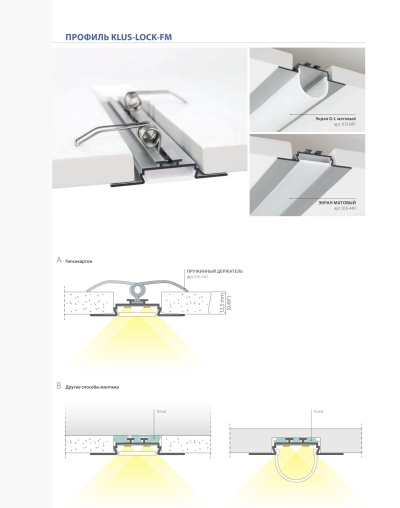
- Products of the renowned European brand Klus, represented by a variety of standard sizes, shapes and a wide range of colors. In the catalog of this company there are models of corner, rectangular and rounded overhead and built-in boxes. This variety allows a potential buyer to choose the most suitable option, focusing on their preferences and interior features. The cost of a profile is determined both by the configuration, material of manufacture and color, and by the length of the strip.
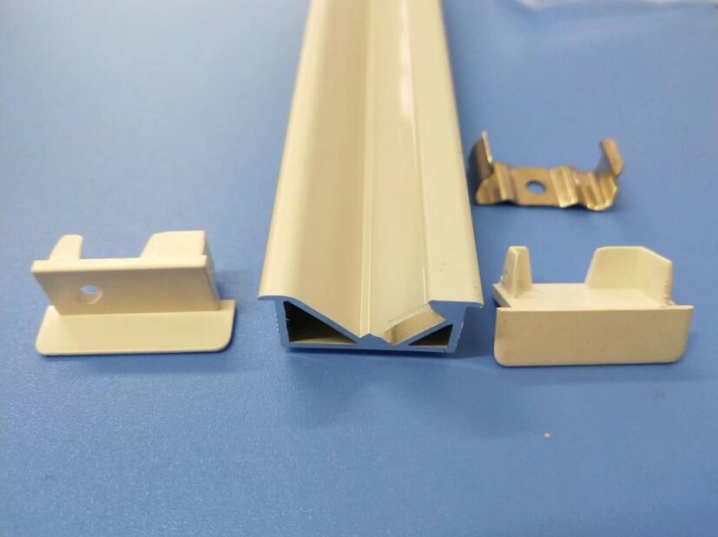
- Another representative of European manufacturers is model line LEDs-ON... In this case, we are talking about design fasteners, which are characterized by original forms. However, one should take into account the relatively high prices both for the profile itself and for accessories.
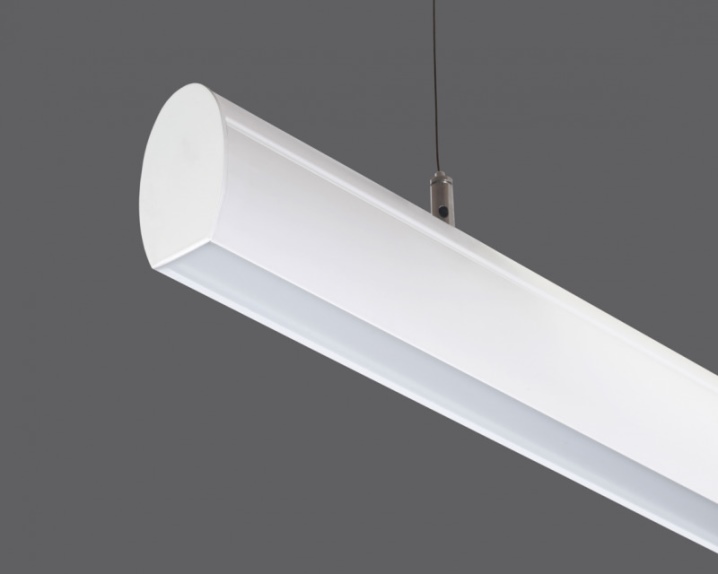
- Arlight brand products, characterized by simplicity of design against the background of the original design. One of the clear competitive advantages of these profile models can be confidently called a rich selection of options and a fairly wide price range, as they say, for any wallet.
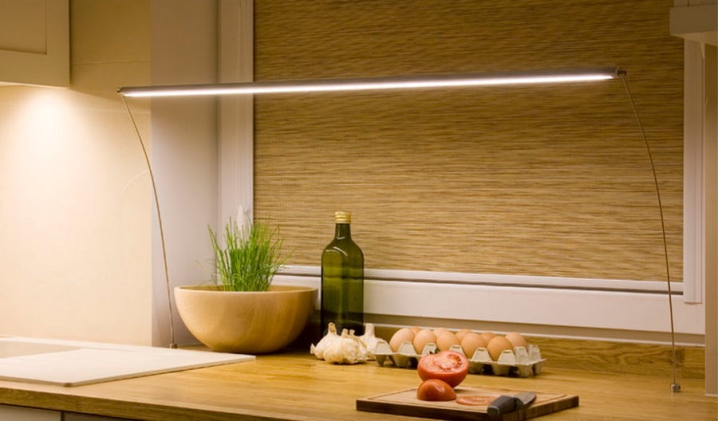
Selection rules
When choosing fasteners for an LED system, it is necessary first of all to focus on the following important points:
- the purpose of the premises or the object being designed;
- place of installation and features of the base;
- the main parameters of the LED strip itself;
- features of the operation of the future lighting system or decorative lighting;
- the type of lighting effect required.
It is no secret that for many, the financial component is at the forefront. In such situations, a profile and additional elements (plugs, connectors, etc.) are selected based on the volume of potential costs. It is important to take into account that the determining factor is, first of all, the material from which the boxes are made. So, an aluminum profile in the overwhelming majority of cases will cost more than a plastic one.
Another important point is the type of guides... The cost of built-in models is higher than that of overhead boxes. However, in this case, it is worth considering the features of the interior.
It is possible to partially reduce costs due to diffusers, but it should be remembered that their absence will negatively affect both the backlighting effect and the safety of the LED strip itself.
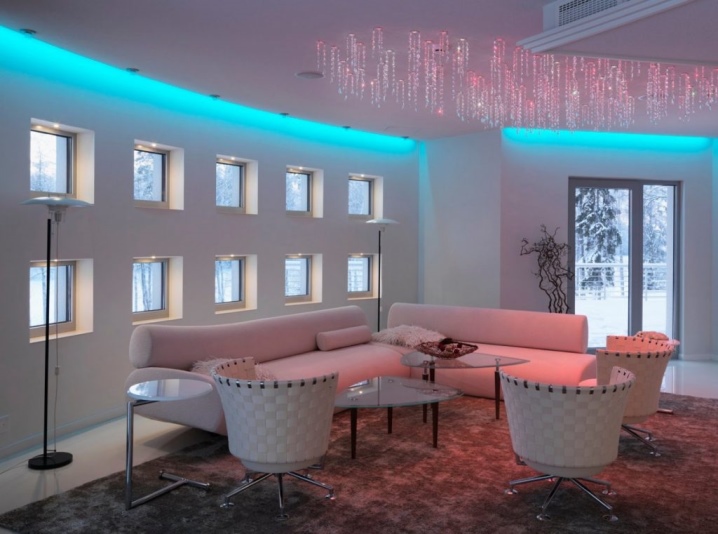
Installation tips
At the initial stage, it is required to determine the length of the future structure, namely the LED strip itself and, therefore, the profile for installation. To do this, you just need to measure the length of the base, on which the boxes will subsequently be fastened.
Regardless of what type and configuration (aluminum or plastic, corner, round, surface-mounted or mortise) the profile is mounted, it is necessary to make a small cut along one of the edges for the supply wire... For fastening the guides, screws are most often used, the dimensions of which depend on the thickness of the material used in the manufacture of the box and the design features of the latter.
In some situations, when installing plastic and silicone products, it is possible to use double-sided tape and adhesives.
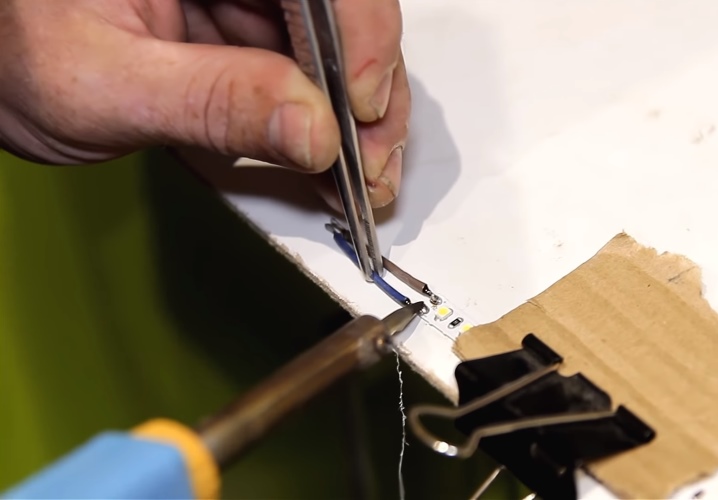
Immediately before installation, the surface of the profile must be thoroughly cleaned and preferably degreased. When performing fastening work, everything must be done as carefully as possible. It should be remembered that LED backlighting most often performs a decorative function, and therefore the design itself must be aesthetic. An equally important point is the integrity of the box, which, among other things, must protect the tape.
When installing the described products, it is required to provide for the ability to access the main working element of the backlight. This is necessary for the maintenance, repair and replacement of LEDs. When installing mortise profiles in the flooring, it is strongly recommended to select areas with the lowest potential stress.
The installation of both the light strips themselves and the guides for them provides for compliance with certain rules and fire safety requirements. At the same time, attention is paid to the correct choice of a place for lighting, which should look as appropriate and effective as possible. If the system is mounted without reference to the implementation of a certain design idea, then the following zones will be most suitable:
- on the ceiling, above doorways or in special niches;
- in the corners of the room;
- behind cornices and skirting boards;
- around the perimeter of various decorative elements.
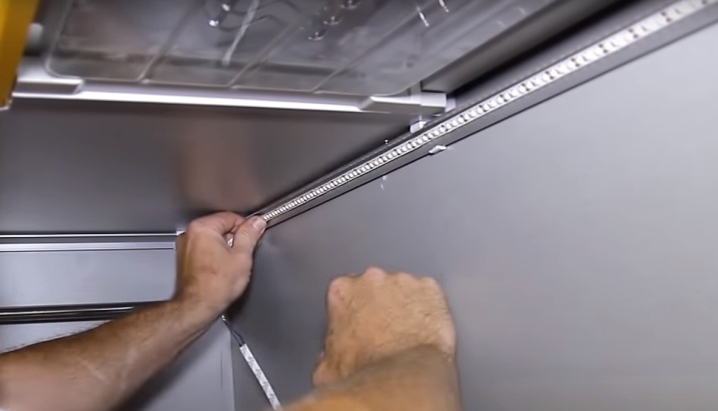
If you need to design more complex interior elements (niches of an unusual geometric shape, arches, etc.), then the best solution would be to use a polycarbonate or silicone profile. Naturally, the key characteristic in this case is the flexibility and ductility of the materials. At the same time, the installation of guides for LED strips is not associated with any significant difficulties.
Special attention should be paid to the design of rooms with high humidity, swimming pools, artificial ponds and aquariums. In such situations, it is important to take into account the characteristics of the environment and establish a sealed profile that can fully prevent the penetration of water.
A similar approach will be relevant when designing outdoor lighting. Naturally, the integrity of the structure is important, which must be taken into account during its installation.













The comment was sent successfully.